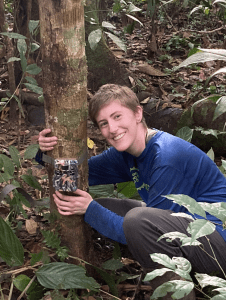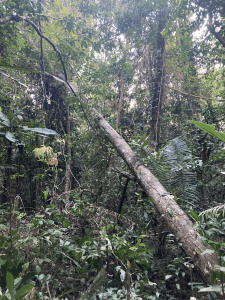My name is Erin Thackray, and I am a senior biology major. This summer, I spent two months at Hoja Nueva in the Peruvian Amazon Rainforest. This organization is focused on wildlife conservation through research and rehabilitation. There I was able to work on several different research projects, but my favorite by far was camera trapping. Camera traps are motion-activated cameras that can be used to remotely monitor wildlife.
On this particular day, we are setting up cameras for our grid specifically designed to capture margays— small, arboreal wild cats. I load up my backpack with the essentials— two full water bottles, lots of bug spray, and of course, the cameras. I pull on my boots, grab a machete, and I’m ready to go. We have five stations to set up today that have already been scouted and marked on our GPS. The spots are what we call margay trees. Through previous research, they have found that margays like to use particular trees, ones that have fallen at about 45 degrees, are wide enough to walk on, and are connected to the rest of the canopy.
 To get to the first point we are hiking on an old logging road. It’s the hottest time of day and I’m already sweating, but the jungle is so beautiful I don’t care. We stop several times along our walk— to look at puma prints, to collect some scat (maybe ocelot!), or to watch a group of tamarin monkeys. Soon it’s time to turn off the trail to bushwhack the last few hundred kilometers to the first point. I hold my machete in front of me, using it to cut vines and push aside branches. It seems like every plant here has thorns or spikes, and I know I won’t make it out of this hike unscathed.
To get to the first point we are hiking on an old logging road. It’s the hottest time of day and I’m already sweating, but the jungle is so beautiful I don’t care. We stop several times along our walk— to look at puma prints, to collect some scat (maybe ocelot!), or to watch a group of tamarin monkeys. Soon it’s time to turn off the trail to bushwhack the last few hundred kilometers to the first point. I hold my machete in front of me, using it to cut vines and push aside branches. It seems like every plant here has thorns or spikes, and I know I won’t make it out of this hike unscathed.
We finally make it to our first point, a huge fallen tree with its branches making a decent margay spot. We spot a good tree to mount our arboreal camera on— one that is about three meters from where we think the margays will be on the fallen tree. The first step is to clear any foliage that will be near the camera. The camera’s sensor can be triggered by moving leaves, and we don’t want its SD card filling up with videos that don’t have any animals.
Now comes the tricky part— we need to attach the camera to the tree several meters high, higher than we can reach from the ground. But we’ve done this before, and I know the drill. My supervisor squats at the base of the tree and I, with a camera in hand, carefully step onto his shoulders. He stands, and now I am at the perfect height to mount the camera. I wrap the camera strap around the tree, make sure the camera is angled perfectly at the area we want to photograph, and turn it on.
Next is the terrestrial camera. We try to find a spot near our margay tree where there are mammal trails. These are trails made not by humans, but by wild animals. They are often barely visible, and it takes close observation to find a good spot.
When we’ve found a good location, we once again clear the foliage and this time mount the camera just above the ground, so we can capture any small animals walking by. When we finish, I rest on a log, careful I’m not sitting on an ants’ nest (it’s almost happened before). I think of all the animals we may catch on these cameras— not just margays, but also birds, brocket deer, pacas, tortoises, coatis, and so many more— and feel so lucky to be able to live and work in such an incredible place.
Experiences like Erin Thackray’s are made possible by the Whitman Internship Grant, which provides funding for students to participate in unpaid internships at nonprofit, some for-profit, and government organizations. We are happy to be sharing blog posts from students who were supported by either a summer, fall, spring, or year-long grants at organizations, businesses, and research labs all around the world. To learn how you could secure a Whitman Internship Grant or host a Whitman intern at your organization, contact us at ccec_info@whitman.edu.
